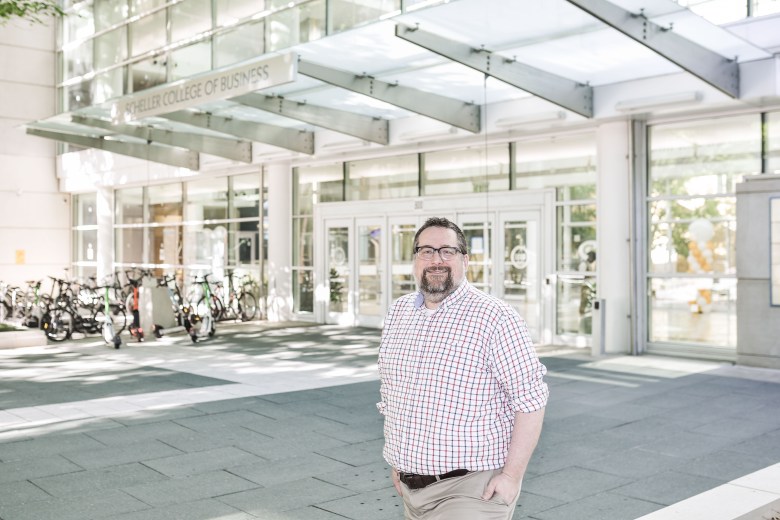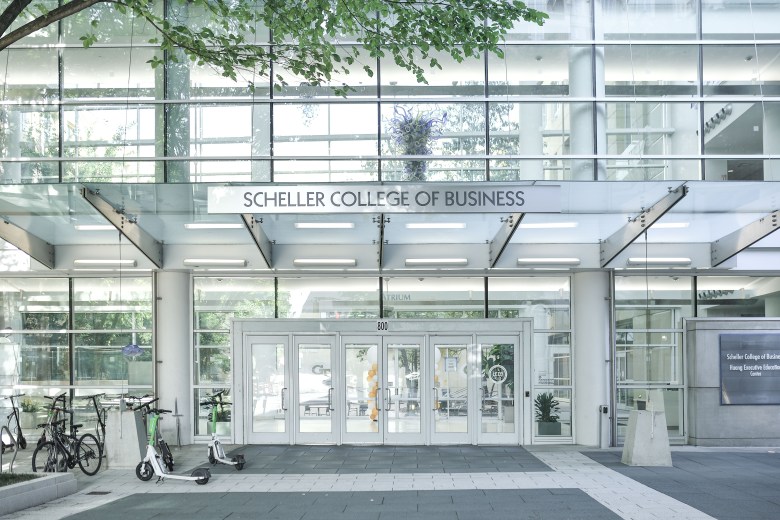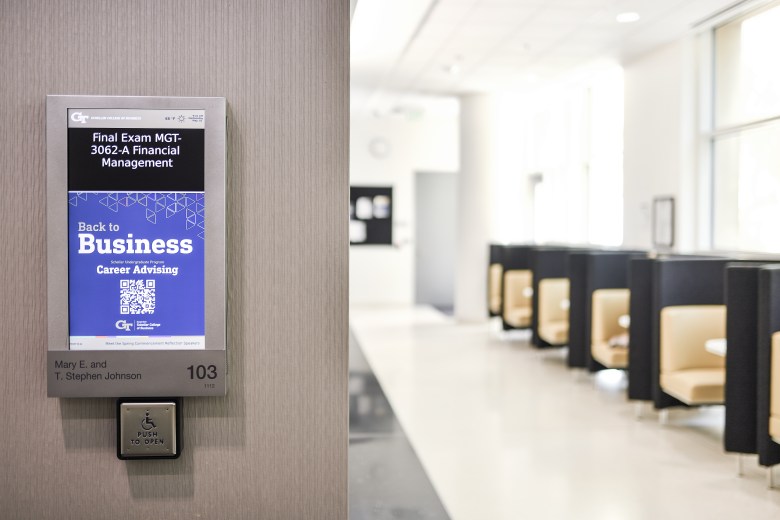ATLANTA — Two construction cranes hover over a giant worksite just outside the Scheller College of Business at the Georgia Institute of Technology.

What they’re building is both a show of optimism in and a way to attract more students to something universities badly need but are beginning to worry about: graduate education.
The $200 million project will house Scheller’s graduate and executive business programs in one tower, connected to Georgia Tech’s School of Industrial and Systems Engineering in another. Linking graduate business programs with other disciplines has proven to increase demand; Scheller has already added a science, technology, engineering and math designation to its master’s program in business administration, with a resulting bump in applications, the school says.
At a university focused on technology, doing this “seemed like a natural fit, and we were seeing some of our competitors doing it,” said Peter Severa, Scheller’s assistant dean for MBA student engagement, in a conference room overlooking the construction site.
It’s also a kind of enticement that’s become essential in response to signs that, after years of increase, the graduate enrollment on which universities heavily rely for revenue may be softening as prospective students question the cost of grad school and as shorter, cheaper and more flexible alternatives pop up.
“What we’re seeing now is a combination of a leveling off and a big question mark as to where this long-term trend will go,” said Brian McKenzie, director of research at the Council of Graduate Schools.
Unlike undergraduate enrollment, which has been on a steady decline, graduate enrollment has gone up over the last decade. Undergraduate numbers fell by 15 percent between 2010 and 2021, according to the National Center for Education Statistics, while graduate enrollment grew by 9 percent. That was fueled in part by a change in 2007 that let graduate students borrow up to the full cost of their educations, unlike undergraduates, who can borrow only a limited amount.
Related: Interested in innovations in higher education? Subscribe to our free biweekly higher education newsletter
This growth made graduate programs a lucrative source of revenue for universities. To cash in, private, nonprofit, bachelor’s degree-granting universities and colleges in particular vastly expanded their graduate offerings, listing more than three times as many by 2021 as they had in 2005, according to research conducted at the University of Tennessee.
It seemed a good bet. Not even the pandemic slowed the increase in graduate enrollment. It reached its highest level ever in 2021, as workers who had been laid off or furloughed opted to get graduate degrees. Then, in 2022, it fell.

There was a slight rebound in the fall of 2023. But that was largely driven by an increase in master’s degree enrollment at public as opposed to private, nonprofit universities and in the number of international students, who have quietly come to constitute much of the growth at graduate schools. Among domestic students, graduate enrollment was starting to decline.
Sheer population trends helped drive graduate enrollment during the last decade, with an increase in the number of Americans who are candidates for it — ages 25 to 44, with bachelor’s degrees.
But even as there are more of those 25- to 44-year-old candidates for graduate education, the proportion of them who actually go has started to erode. It’s down from 8.4 percent to 6.5 percent over the last 10 years, the higher education research and advisory firm Eduventures found.
“If that continues, and you see a slowing in the underlying population growth, then we’re starting to talk about some challenges,” said Clint Raine, senior analyst at Eduventures.
That’s because of a looming decline in the number of 18-year-olds beginning next year, which is projected to take another big toll on undergraduate enrollment. Basic math suggests that it will eventually hit graduate programs, too.
“The next five years we may be safe,” said Lily Bi, president and CEO of the Association to Advance Collegiate Schools of Business, or AACSB. “But five years down the road, I think we really need to watch.”

There are other challenges. All those graduate programs that universities rushed to add meant that, even when graduate enrollment was going up, the number of students per program — and, therefore, the revenue that institutions made from them — was going down.
“The issue is that graduate student growth has not kept pace,” Raine said. “So we’ve seen a flood of programs in the market, but student demand has not kept up.”
Another challenge for graduate programs: A strong labor market has many people staying in their jobs instead of furthering their educations.
“The choice became, ‘Do I go to graduate school or do I look at some of these very good opportunities?’ Many of them chose to go with the money,” said Julia Kent, vice president for best practices and strategic initiatives at the Council of Graduate Schools.
Meanwhile, there has been a proliferation of alternatives to traditional graduate degrees.
“A prospective student today has never had more options,” Raine said.
Interest in traditional master’s degrees is down since 2019, Eduventures found, while interest in lower-price, shorter-term certificates and other nondegree offerings is up.

“We live in a fast-food society,” Bi said. “People want something easy, something fast.”
And flexible. Twenty-seven percent of master’s programs and 66 percent of MBAs are now offered online, giving students more choice of when and where to take them. That’s up from 12 percent and 36 percent, respectively, in 2012.
Students’ preference for part-time and online MBA programs translated into an increase in applications for those programs in the academic year that started in the fall, the Graduate Management Admission Council says. But applications overall were down by 3 percent, as enthusiasm waned for more conventional and expensive in-person versions, whose enrollments fell.
Related: Universities increasingly turn to graduate programs to balance their books
There has also been growing coverage of and skepticism about the high amount of debt students assumed for graduate programs that don’t necessarily result in earnings high enough to allow them to repay their loans. Those programs are disproportionately at private, nonprofit universities, which charge twice as much as public universities for master’s degrees in fields such as social work, according to a study by the Urban Institute.
The increase in borrowing for graduate study has sparked a warning from the U.S. Department of Education, which notes that growing numbers of borrowers are finishing their graduate educations with very high levels of debt. And while people with graduate degrees generally earn more than people without them, that premium has flattened out, “suggesting a potential decline in the net return,” the department’s chief economist observed.
At 15 percent of master’s, doctoral and professional programs, the median graduate makes less than the median undergraduate degree holder, according to a separate study by three think tanks across the political spectrum: the American Enterprise Institute, EducationCounsel and The Century Foundation.
The average graduate federal student loan holder owes $70,000, that study found, and one in five has borrowed more than $100,000.
While 90 percent of students who are studying toward or just got bachelor’s degrees say they are interested in graduate school, more than half consider the return on investment an important part of their decision, a survey by the higher education marketing firm Spark451 found. That’s the same questioning of value that has been eating away at undergraduate enrollment.

“We have to think about who’s on the doorstep now to graduate programs. It’s Gen Z. They’re that prime graduate-going cohort, and we know from some of our research that this generation is more price- and cost-sensitive compared to the last,” Raine said.
Mindful of this, the Council of Graduate Schools has created a task force to study the cost of graduate education and has recommended expanding eligibility for Pell Grants to graduate students and lowering the graduate student loan interest rate from the current 8.05 percent, Kent said.
Graduate students represent only a little more than a fifth of all students but account for nearly half of federal student borrowing, according to the U.S. Department of Education.
American students who have enrolled in graduate schools are less than enthusiastic about the value of it. Just over half say it was “definitely worth it,” a survey by the think tank Third Way found.
Related: Colleges are now closing at a pace of one a week. What happens to the students?
That has left universities to increasingly rely on one market that continues to grow: international graduate students. A closer look at the data shows that they now account for almost all of the rise in graduate enrollment.
The number of international students in U.S. graduate programs rose 21 percent in 2022 — compared to a 4.3 percent increase among international undergraduates — and 22 percent in 2023, according to the National Student Clearinghouse Research Center.
In almost every graduate field that reported an increase in enrollment, it was due to a big jump in the number of international students, even as the numbers of U.S. citizen and permanent resident students fell.

The number of graduate business students who are U.S. residents or permanent residents dropped 7 percent while the number from other countries went up 19 percent in the fall, AACSB figures show.
That growing dependence on international students could be risky, as became clear during the pandemic, when they all but disappeared. Geopolitical tensions also could have an impact; though more international students continue to come to the United States from China than from any other country, the number of Chinese students fell slightly last year, according to the Institute of International Education.
Still, McKenzie, of the Council of Graduate Schools, pointed out that the number of students from India increased 35 percent during the same period.
Universities are aggressively recruiting international students. Georgia Tech’s STEM designation for its MBA program was devised in part as a way to help reverse a steady decline in the number of full-time MBA students.
Related: Universities and colleges search for ways to reverse the decline in the ranks of male students
That’s because a STEM designation allows international students to stay in the United States and work in their fields of study, without an employer sponsor, for three years after earning a degree, compared to the usual limit of one year.

“If a large portion of our applicants are international, it’s important to be attractive to them,” said Emily Sharkey, Scheller’s executive director of MBA admissions and recruiting. That third year of a visa “is a game-changer as we look at our applications,” added Dave Deiters, associate dean of MBA programs at Scheller, who heads up its career center.
Among other universities whose business schools have added STEM designations: Arizona State, Carnegie Mellon, Duke, Indiana, Michigan, Northwestern and Rice.
Incorporating technology into business education also appeals to undergraduates who might eventually be candidates for graduate degrees.
Even as an undergraduate at Scheller, “I’ve learned coding and stuff I probably wouldn’t have learned at other business schools,” said Elizabeth Curvin, who just finished her sophomore year there. “Compared to my friends at other business schools, we get a lot more of that,” said Amelia Fox, a junior. “You’re set up very well.” And Daniel Manning, a junior, already has a concentration in strategy and innovation. “That gives you practical information about how to manage engineers,” he said.


But none was ready to commit to investing in an MBA.
“I’d probably go out to the workforce and see if it was something that I wanted,” Curvin said. Junior Aubrey Charron said she also wants to try out her planned career in hospital administration first, “just to make sure I’ve really found what I want to do.”
Concerns about graduate enrollment go beyond what students might earn or owe, or how such changes might affect universities’ bottom lines. There are growing shortages of workers who require graduate degrees, the Council of Graduate Schools says.
“It is concerning that domestic enrollment is slightly down, because it will be critical to have more Americans participating in graduate education,” said Kent, at the Council of Graduate Schools.
Yet what’s happening at graduate schools has so far been eclipsed by a focus on falling undergraduate enrollment, Raine said.
“It’s a very much less discussed future trend that we certainly are trying to shed more light on.”
This story about graduate enrollment was produced by The Hechinger Report, a nonprofit, independent news organization focused on inequality and innovation in education. Sign up for our higher education newsletter. Listen to our higher education podcast.



